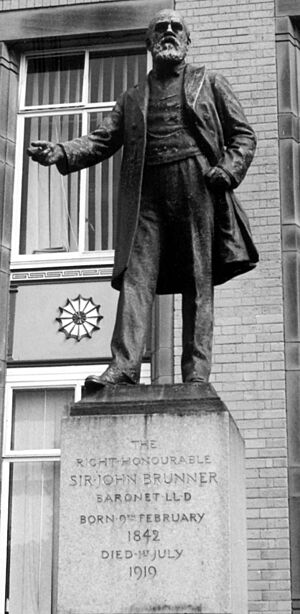Statue of Sir John Brunner facts for kids
The Statue of Sir John Brunner stands outside Mond House in Winnington, Cheshire, England. Sir John Brunner was an important English businessman, politician, and a generous helper in his local area. He joined a company that made chemicals called alkali in 1861.
Later, he teamed up with a chemist named Ludwig Mond. They built a factory in Winnington to make alkali using a new, better method. This factory, called Brunner Mond, grew to be the biggest producer of soda (a type of alkali) in the world. Brunner also became a Member of Parliament for over 30 years. He used his wealth to help his community. The statue was made by Goscombe John and was first shown in 1922. In 1995, it was moved to stand next to the statue of Ludwig Mond. This statue is a special Grade II listed building, meaning it's an important historical structure.
Contents
The Story of Sir John Brunner and His Statue
Early Life and Business
John Tomlinson Brunner was born in Liverpool in 1842. When he was 15, he started working in an office. In 1861, he moved to work at an alkali factory in Widnes. His older brother, Henry, already worked there. John Brunner soon became the office manager.
The factory used an old method called the Leblanc process to make alkali. This method was not very good and also harmed the environment. A chemist at the company, Ludwig Mond, knew about a better way to make alkali. This was called the ammonia-soda process.
By 1871, Mond decided to build a factory using this new process. Brunner joined him as a partner. In 1873, Mond and Brunner bought the Winnington estate near Northwich. This included a large house called Winnington Hall. Both families lived in the hall, and their new factory was built nearby. This was the start of their company, Brunner Mond and Company. By 1892, their company was the largest soda producer in the world. Brunner became the company's chairman in 1891 and stayed in that role until 1918.
Brunner's Political Career and Kindness
After moving to Winnington, Brunner became interested in politics. He joined the Liberal Party. He was chosen to represent the new area of Northwich in Parliament. In the general election of 1885, he won the seat.
However, his success was short-lived. The Liberal Party could not form a strong government. Brunner lost his seat in the election the next year. But the person who won died soon after. In a special election in 1877, Brunner won his seat back. He remained a Member of Parliament for Northwich until he retired in 1910.
People in the area saw Brunner as a kind and caring boss. He was also very generous. For example, he helped build a new library in Northwich. He also helped fund Sir John Deane's College in the town.
Creating the Statue
After Brunner died in 1919, a group was formed to create a statue in his memory. His son, Roscoe, asked Goscombe John to design it. The design was approved. The statue is made of bronze and was created at a special workshop in Thames Ditton. The stone base was made by a company in Manchester.
The statue was placed between the Brunner-Mond factories in Winnington and Willerscote. It was near the statue of Ludwig Mond. The statue was officially shown on June 10, 1922. Brunner's sons, John and Roscoe, and his wife were there. Also present were Alfred Mond (Ludwig's son), Lord Leverhulme, and Louis Solvay.
In 1995, the statue was moved to its current spot outside Mond House. This building is the main office of the company Brunner and Mond started. The Duchess of Kent, who is Brunner's great-granddaughter, officially unveiled it there. It stands right next to the statue of Mond.
What the Statue Looks Like
The statue shows a bronze figure standing on a stone base. The figure is about 1.8 meters (6 feet) tall. The base is about 2.2 meters (7.2 feet) high. The statue is life-size and shows Brunner with a beard. He is wearing a formal coat. His left thumb is in his pocket, and his right arm is stretched out. This pose shows how he often stood when speaking to people in public.
The stone base has an inscription that reads:
- THE RIGHT HONOURABLE SIR JOHN BRUNNER, BART., LL.D.
- BORN, FEBRUARY 9TH, 1842, DIED 1ST JULY 1919
At the bottom of the base, you can see the names of the company that made the statue and the sculptor.
Why the Statue is Important
The statue was named a Grade II listed building on August 19, 1986. Grade II is the lowest of three levels for listed buildings. It means the building or structure is important to the country and has special historical interest.
Soon after the statue was unveiled, a local newspaper called it "a fine piece of creative sculpture." They praised its "vigour and energy." They also said it would be a "fitting companion" to the statue of Dr. Mond. Experts have also commented that Brunner's statue looks "much more forthcoming" than Mond's.


